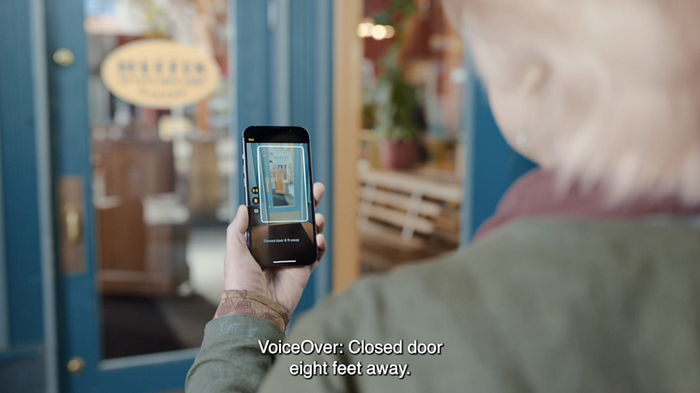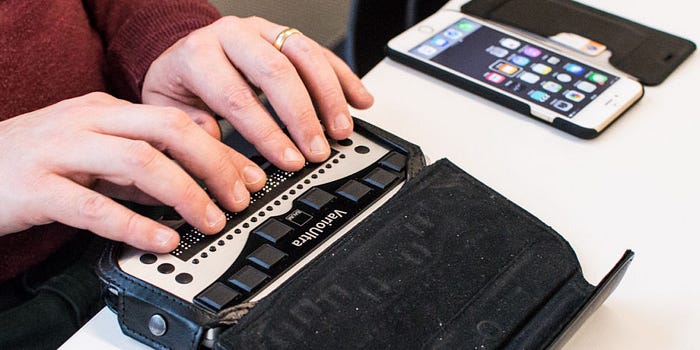

Where the Future of Accessibility in Tech Is Headed
source link: https://uxplanet.org/where-the-future-of-accessibility-in-tech-is-headed-aeaa49d9079f
Go to the source link to view the article. You can view the picture content, updated content and better typesetting reading experience. If the link is broken, please click the button below to view the snapshot at that time.

Where the Future of Accessibility in Tech Is Headed
Exploring the advances in accessibility for tech products
Accessibility is an incredibly important topic and one that has come a long way. In the past, tech products were often designed with a one-size-fits-all approach, which meant that people with disabilities were often left out and unable to fully participate in the digital world.
But thankfully, we have seen a shift toward more inclusive design in recent years. Many tech companies are now making a conscious effort to create products that are accessible to everyone, regardless of their abilities. This is a step in the right direction, but there is still much work to be done.
In this article, I want to explore the current state of accessibility in tech and where I believe we are headed in the future.
The current state of accessibility
In terms of design, we’ve seen companies prioritize accessibility in their product development.
Design toolkits
Microsoft has made its Inclusive Design Toolkit available which provides guidance to designers and developers to create products that are accessible to everyone, regardless of their ability. IBM also launched its own Equal Access Toolkit in a similar effort to educate designers and developers.
Web accessibility compliance
Many websites and apps now have features like high contrast mode, closed captions, and the ability to adjust the font size, which makes it easier for people with visual impairments to use them. However, despite these efforts, many digital products are still not fully compliant with web accessibility standards.
Specialized assistive technologies
The availability of smartphones with built-in assistive technology has made it easier for people with a wide range of disabilities to stay connected and access information.
For example, Apple’s iOS operating system has built-in features that allow users to customize the interface and make it easier to use for those with vision or motor impairments. Door Detection is Apple’s latest navigation feature that helps people with vision impairment detect and locate doors around them.

Voice-controlled devices can make it easier for those with motor impairments to use products without having to use a keyboard or touch screen. An example is the Tobii Dynavox, which uses voice control to help people with severe impairments communicate and interact with the world around them.
The future of accessibility
We’ve come a long way in making technology more accessible for people with disabilities, but there is still so much room for improvement.
Just imagine a world where technology seamlessly adapts to the needs of people with disabilities, allowing them to live independently and fully participate in society.
Here are a few use cases where technology can be used to improve people’s lives.
Artificial intelligence (AI) and machine learning (ML)
AI and ML are already being used to improve accessibility in areas such as speech recognition and text-to-speech, but as they continue to advance, they will become even more powerful tools for improving accessibility.
A use case for AI could be providing real-time translation for people with hearing impairments, enabling them to fully participate in meetings and other work-related activities. This can help break down language barriers and allow people from diverse backgrounds to easily communicate with one another.
ML could be used in the healthcare industry to help people with disabilities manage their health. For example, a machine learning-powered system could track a person’s vital signs and provide alerts if there are any concerning changes. It could also provide personalized recommendations for managing conditions such as diabetes or high blood pressure.
Virtual reality (VR) and augmented reality (AR)
Think about how VR could be used for rehabilitation exercises, allowing patients with physical disabilities to practice movements in a safe and controlled environment. This could be a game changer for people who have trouble with manual therapy, making it more engaging and easier for them to recover.
AR could be used to provide accessible transportation information for people with visual impairments. For example, AR can be used to provide real-time information about bus or train schedules or to provide audio or visual directions for people with visual impairments. This could greatly improve the independence and mobility of people with visual impairments, making it easier for them to navigate the world around them.
Voice interfaces
Voice assistants like Alexa and Google Assistant have become household names that enable people with mobility impairments to control lights, temperature, and other household functions without having to physically interact with the devices.
But in the future, they will become even more accessible and inclusive, with improved speech recognition and natural language processing (NLP) capabilities. This could greatly improve the independence and quality of life for people with disabilities, making it easier for them to live comfortably in their own homes.
Voice interfaces could also be used to provide accessible communication for people with speech impairments. For example, a voice-controlled messaging app can allow people with speech impairments to communicate with others by typing their message and having it read out loud. This could greatly improve the social lives of people with speech impairments, making it easier for them to connect with others and form relationships.
The possibilities are endless.
Accessibility training
As a product designer, incorporating accessibility into our design process is not only necessary but it’s the right thing to do.
To that end, design leaders should take the time to provide training in accessibility to their team. The training should cover a range of topics, including best practices for conducting user research with people with disabilities, techniques for usability testing, and guidelines for designing accessible products.
If possible, bring in experts in accessibility to lead the training, who can speak to their deep expertise. Give designers the opportunity to experience first-hand assistive technologies, such as screen readers and Braille displays. This can help them gain empathy for users that have disabilities and keep them in mind throughout their design process.

The benefits of receiving accessibility training are numerous. For one, it will give designers valuable insights into the unique accessibility needs of different groups of users, which in turn will inform their design decisions. Additionally, by conducting usability testing with people with disabilities, designers will be able to identify and fix accessibility issues early on, resulting in a better final product.
Final thoughts
It’s important to remember that accessibility is not just a “nice to have” feature, but it is a fundamental aspect of creating inclusive and equitable products. As designers, it’s our responsibility to create products and services that are accessible to everyone, regardless of their abilities.
In the future, I hope that accessibility will be a standard consideration in all product development and design processes. I believe that by working together and investing in accessibility training, research and testing, we can make the future of technology a more inclusive and accessible place for everyone.
Recommend
About Joyk
Aggregate valuable and interesting links.
Joyk means Joy of geeK